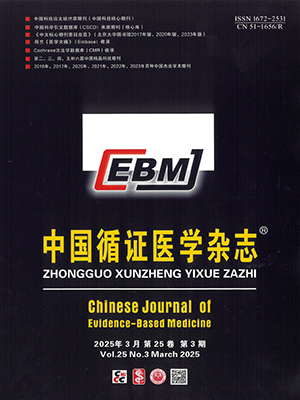| 1. |
祁维良. 抗心律失常药物诱发或加重室性心律失常. 国外医学 (心血管疾病分册), 1983, (2): 118-120.
|
| 2. |
李晓黎, 王建平. 开展中草药注射剂不良反应集中监测确保用药安全. 海峡药学, 2010, 22(12): 315-317.
|
| 3. |
郭艳, 徐厚明. 完善医院集中监测制度提高医生的依从性. 中国药事, 2010, 24(1): 71-72.
|
| 4. |
中华人民共和国卫生部. 《药品不良反应报告和监测管理办法》(卫生部令第 81 号). Available at: http:∥www.sda.gov.cn/WS01/CL0053/62621.Html.
|
| 5. |
Crombie I. Pocket guide to critical appraisal. London: John Wiley&Sons, 1996, : 80-87.
|
| 6. |
姚鸿雁. 基于回顾性巢式病例对照方法的中药注射剂临床安全性再评价研究. 郑州: 河南中医学院, 2015.
|
| 7. |
黎元元, 雷蕾, 谢雁鸣. 31724 例灯盏细辛注射液安全性医院集中监测研究. 中国中药杂志, 2015, 40(24): 4757-4761.
|
| 8. |
张庆丽. 基于医院集中监测的丹红注射液临床安全性与影响因素研究. 北京: 中国中医科学院, 2017.
|
| 9. |
王乐, 陈晨, 张洪峰, 等. 康莱特注射液上市后临床安全性医院集中监测研究. 环球中医药, 2016, 9(3): 372-373.
|
| 10. |
于倩, 赵阿娜, 付秀娟. 多中心非干预前瞻性开放的 3000 例苦碟子注射液应用情况及不良反应集中监测. 中国药物应用与监测, 2015, 12(3): 167-170.
|
| 11. |
张庆丽, 王忠, 荆志伟, 等. 清开灵注射液上市后安全性医院集中监测 5800 例. 中国药物警戒, 2015, 12(7): 417-419, 423.
|
| 12. |
常艳鹏, 萧伟, 杨伟, 等. 热毒宁注射液医院集中监测不良反应特征分析. 中医杂志, 2014, 55(9): 791-794.
|
| 13. |
王志飞, 赵维, 张寅, 等. 基于大型前瞻性安全性监测的参附注射液不良反应影响因素分析. 中国中药杂志, 2015, 40(24): 4746-4751.
|
| 14. |
王连心, 谢雁鸣, 艾青华, 等. 参麦注射液上市后临床安全性主动监测与被动监测大数据综合评估. 中国中药杂志, 2015, 40(24): 4752-4756.
|
| 15. |
王连心, 谢雁鸣, 艾青华, 等. 医院集中监测嵌套巢式病例对照设计的 30026 例参芪扶正注射液上市后临床安全性研究. 中国中药杂志, 2015, 40(24): 4739-4745.
|
| 16. |
杨伟, 王连心, 谢雁鸣, 等. 10029 例感染性疾病患者常用中药注射剂安全性医院集中监测分析. 中医杂志, 2014, 55(8): 666-669.
|
| 17. |
姜俊杰, 谢雁鸣, 张寅, 等. 30209 例舒血宁注射液安全性医院集中监测研究. 中国中药杂志, 2017, 42(15): 2883-2888.
|
| 18. |
姜俊杰, 谢雁鸣, 张寅, 等. 32546 例疏血通注射液医院集中监测研究. 中国中药杂志, 2016, 41(20): 3852-3858.
|
| 19. |
何芳, 陈赫军, 张霄, 等. 我院血必净注射液的 ADR 集中监测研究. 中国药房, 2017, 28(29): 4089-4092.
|
| 20. |
李利军, 胡晋红, 王卓, 等. 药品不良反应严重程度分级评分标准的制定及药品不良反应严重度指数的应用. 药学服务与研究, 2008, 8(1): 9-13.
|
| 21. |
杨志伟. 老年人药物不良反应临床特点的研究. 长沙: 中南大学, 2008.
|
| 22. |
唐进法, 徐涛, 孟菲, 等. 合并用药对丹红注射液安全性的影响. 中国实验方剂学杂志, 2013, 19(13): 294-297.
|
| 23. |
王元培. 痰热清注射液的配伍禁忌. 中国药物与临床, 2010, 10(10): 1149-1151.
|
| 24. |
李廷谦. 中药注射剂不良反应及临床合理用药. 中国循证医学杂志, 2010, 10(2): 111-115.
|
| 25. |
李学林, 唐进法, 孟菲, 等. 10 409 例丹红注射液上市后安全性医院集中监测研究. 中国中药杂志, 2011, (20): 2783-2785.
|
| 26. |
李春晓, 徐涛. 133 例中药注射剂不良反应报告分析. 中国医药导报, 2011, 8(25): 114-116, 121.
|
| 27. |
杨丽君, 邓剑雄, 林国良, 等. 323 例儿童严重药品不良反应报告分析. 中国药物警戒, 2008, 5(2): 108-113.
|
| 28. |
费汝倩. 中药注射剂不良反应的发生率及影响因素研究. 长沙: 中南大学, 2013.
|
| 29. |
雷普. 中药注射剂不良反应发生率调查及影响因素分析. 世界最新医学信息文摘, 2015, 15(A0): 187-188.
|
| 30. |
王文萍, 喻明, 王丽, 等. 中药新药临床试验不良反应及其相关影响因素的学术探讨. 中国中药杂志, 2015, 40(2): 346-350.
|
| 31. |
吕良忠, 俞佳, 方晴霞. 我院 2006-2008 年住院病人药品不良反应发生率的比较研究. 中国现代应用药学, 2011, (5): 468-471.
|
| 32. |
罗小明. 中药注射剂不良反应发生率及影响因素研究. 甘肃科技, 2015, 18: 133-134.
|
| 33. |
王建刚, 王永铭. 药物不良反应监测研究-7 种抗生素不良反应调查分析. 中国临床药理学杂志, 1991, 1: 44-54.
|
| 34. |
Granata V, Cascella M, Fusco R, et al. Immediate adverse reactions to gadolinium-based mr contrast media: a retrospective analysis on 10608 examinations. Biomed Res Int, 2016, 2016: 3918292.
|
| 35. |
邢希旺, 李永吉, 冯宇飞, 等. 中药注射剂致敏性与生产工艺相关性探讨. 中医药信息, 2012, 29(6): 52-54.
|
| 36. |
程昆木. 刺五加化学成分研究. 长春: 吉林农业大学, 2007.
|
| 37. |
曾晓敏. 中药注射剂不良反应与辅料关系及应对策略探讨. 广东省药学会: 2016 年广东省药师周大会论文集, 2015: 3.
|
| 38. |
张俊华, 胡镜清, 谢雁鸣, 等. 中药注射剂临床安全性集中监测研究设计与实施专家共识. 中国中药杂志, 2017, 42(1): 6-9.
|




